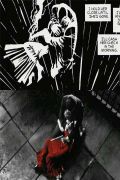
Directed by
Robert Rodriguez / Frank Miller / Quentin Tarantino
124 minutes
Rated MA
Reviewed by
Bruce Paterson

Sin City
Synopsis: Sin City is infested with criminals, crooked cops and sexy dames; some searching for vengeance, some for redemption and others, both.
Robert Rodriguez' oeuvre thus far is a kaleidoscope of visual effects that usually tell a simple story well. He was made for turning pulp fiction into celluloid, and his dedication to realising Frank Miller's silhouetted and polarised fantasy crime comics pays off. Images are worth a few gazillion words here - Miller was apparently convinced to unprise his fingers from the film rights by Rodriguez turning up with the opening sequence already in the digital can:
 |  |  |
The dramatic black and white comic visuals are lovingly transferred, almost comic frame for cinema frame, to a predominantly colour-free screen. Rodriguez adds splashes of colour to pick out details or accentuate highlights. The occasionally extreme comic-violence is manageable - blood spurts luminescently, a gruesome evisceration is masked by hard-edged black and white. This is the stuff of the classic noir detective style, but with a feral edge to both the style and the content. It's lazy, and perhaps unfair to Rodriguez, to say it's Tarantinoesque; but I'm going to anyway - especially given the most feral scene was guest-directed by Mr T. Unlike Tarantino, the film is a bit of a patriarchal package - even the gun-toting dames need a manly helping hand in the end; but ultimately the genders make a partnership that loosens the black grip that crime holds over Sin City.
 |  |  |
The cast is a huge list of names spread over the three intertwining Sin City comics stories that comprise the film. Jessica Alba is the dark city's bar-dancing angel. Mickey Rourke is transformed into a hulking, but human, vengeance machine. Benicio Del Toro won't shut up even with a slit throat. Rosario Dawson leads a pack of fearsome Amazons. Bruce Willis is the last honest cop. Clive Owens is out to play a dark hero. Elijah Wood is the freakiest character in memory. Alexis Bledel, Carla Gugino, Devon Aoki, Rutger Hauer, Michael Madsen - all play a part to bring a big story with real dimensions to the screen.
The film was shot almost exclusively against green screens, but the performances are very alive and in sync with the ultra-realistic surroundings. Unlike George Lucas' recent efforts, Rodriguez seems to have succeeded in overcoming the performance hesitancy often apparent in this kind of film-making. He shoots and cuts fast and well, capturing a palpable immediacy and tension in the performances. The staccato dialogue also transfers faithfully from page to screen.
Ultimately, two of the three stories are riveting, but one interrupts the pacing a little. Perhaps this is like Mozart being told that there were too many notes. What's being done here is very fresh meat, and well worth consuming. The imitators will, of course, be right around the corner. Hopefully Sin City 2 won't be one of them, but will add even more innovation to a very impressive beginning.
FYI: There was a 2014 sequel Sin City: A Dame To Kill For, also directed by Miller and Rodriguez that did not impress critically or at the box office.

Want more about this film?


Want something different?




